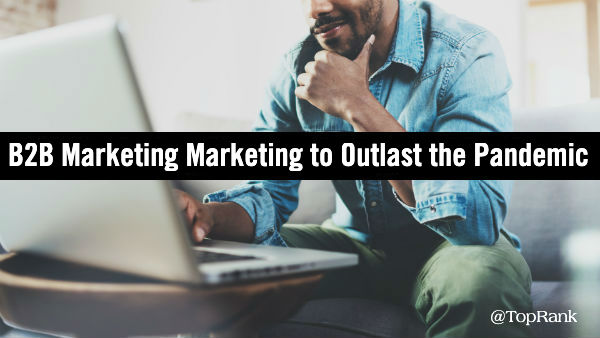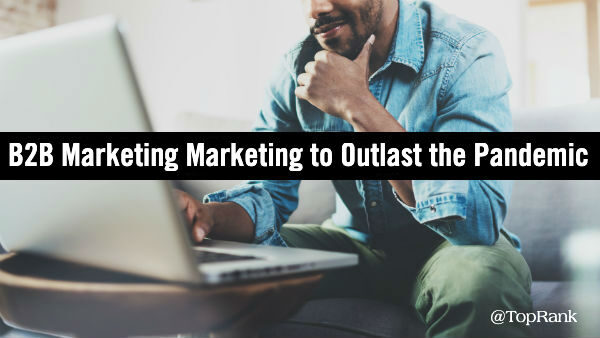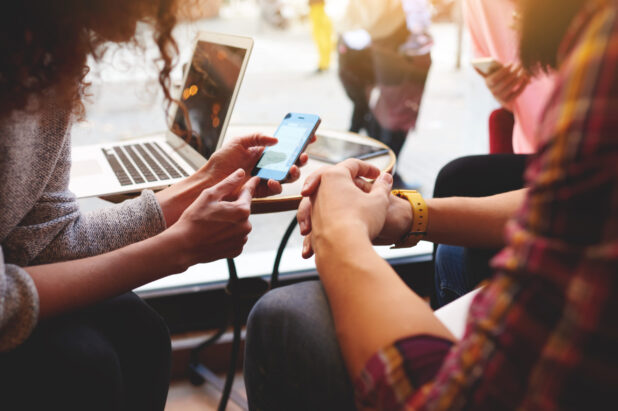
Without question, the COVID-19 pandemic has had an impact on the B2B world with companies generally reducing marketing budgets. At the same time, many B2B companies are maintaining or increasing marketing spend as we’ve seen with most of our clients at TopRank Marketing.
While there has generally been a shift from explicit sales/push marketing content to brand messaging that is more aligned with the times and empathetic to customers, sales expectations still exist for B2B brands during the COVID-19 pandemic.
The challenge many B2B marketers are facing is to understand how to navigate both the short term changes in what works for customers in the current environment as as well as in the long term, post-crisis.
According to research from McKinsey, one of the biggest changes that has happened is the boost in importance of B2B digital over traditional means of engaging customers – 200% more than before COVID-19. This move to digital means higher expectations by B2B customers of self service as well as B2B ecommerce experiences. With those changes in expectations come changes in marketing, short and long term.
Not only do B2B companies need to mitigate sales losses because of the uncertainty during the pandemic but those who want to continue being the best solution and top of mind for customers when purchasing behavior comes back need to look at what pandemic-era tactics will stick after the crisis has subsided.
For a great overview of how to measure marketing goals in a crisis, be sure to check out Birdie’s post here.
How buyers feel about B2B brands short and long term will directly contribute to which brands are the most relevant as budgets open up and business solutions investments experience substantial growth. Some of the long term metrics include branding goals measured by share of voice for social, share of search and earned media.
So, can B2B marketers do to optimize and measure their pandemic era marketing?
Content is the kingdom. Providing customers with information and resources for surviving and thriving during the pandemic that are useful from the customer’s perspective is a good starting point. Demonstrating how the B2B brand’s solution provides value in the current environment is also essential for creating relevance and utility with customers. Of course, useful information isn’t all there is. The shift towards digital, B2B brands need to make sure the digital experiences they provide are 100%: Information is easy to find, the inquiry or ordering process is easy and fast, there are zero glitches in using online systems.
Search is even more relevant. As mentioned in the research from McKinsey, self service is an increasing expectations amongst B2B buyers. One way buyers are performing self serve marketing is through the use of search engines.
An emphasis on search also helps B2B brands reach sales goals without being “salesly”. This trend has been picked up on by savvy B2B marketers with 63% of marketers saying it will be most important during the pandemic according to a survey by Conductor. This confidence is also exemplified from data reported by G2 Crowd showing B2B tech categories having a 200-600% increase in organic search traffic during the pandemic.
Of course to make search work, B2B brands need content and SEO best practices in place to ensure optimized visibility for what customers are looking for. We’ve seen many B2B brands emphasize SEO during the pandemic which enables buyers who are no longer attending trade shows and engaging in experiential or field marketing activities to use search engines for finding useful information and solutions on their own terms.
Findability works best with credibility. Customers are as skeptical of brand marketing as ever and are tiring of the “in these uncertain times, we’re here for you” ads and messaging. While bypassing that with search engine optimization and advertising works well for connecting with customers, optimized content that has added 3rd party credibility can work even better.
In our own research in the 2020 State of B2B Influencer Marketing Report, 77% of B2B marketers say their prospects rely on influencers for information. Confidence in influencer marketing is on the rise for B2B marketers. 63% of survey respondents believe they would have better marketing results with an influencer marketing program.
So, crisis era marketing that emphasizes SEO to help buyers pull themselves to brand content that also includes credibility inspiring content from industry experts is what can really create trust and the confidence for buyers to make the connection. This is why SEO and influence are essential partners for any B2B marketing effort during and after the pandemic.
Measuring the impact of B2B content marketing that is optimized and influencer activated means understanding the search phrases and topics of influence that are most relevant for customers and then tracking the brand’s relevance, engagement and conversion for those topics.
For search marketing, key measures include:
- Topic visibility reporting & share of search for those topics
- Referred traffic to content optimized for the target topics
- Conversions from target topic content
Influencer marketing, metrics to track include:
- Share of voice on topics of include
- Growth of brand affinity with influencers
- Reach of topic content amongst influencer networks
- Engagement and conversion performance of topic content shared by influencers
- Growth in affinity of topics and brand in social
- Growth of organic brand advocacy by influencers and their networks
Uncertainty is a dangerous state for businesses and making no decision is often worse than making the wrong decision or failing fast. Understanding the shifts in buyer behavior can help B2B brands gain confidence in the role content marketing will play in the short and long term. Relevant content that is both findable for increasingly self-serve buyers and credible through industry expert contributions can give the competitive advantage needed to perform both short term and post-pandemic.



